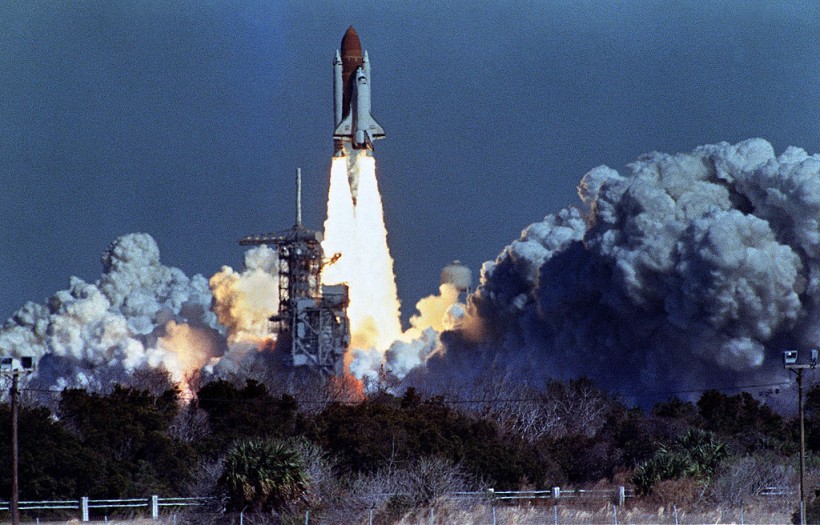A group of divers found a large section of the destroyed space shuttle Challenger that has been buried in the sand at the bottom of the Atlantic Ocean, over 30 years after the tragedy that killed seven astronauts.
NASA's Kennedy Space Center announced the discovery on Thursday, November 10. NASA manager Michael Ciannilli confirmed the remnant's authenticity and said that he felt his heart skip a beat after seeing the underwater video footage as it brought back memories of the 1986 disaster. It is the first remnant to be discovered since two fragments of the left wing washed ashore in 1996.

US space shuttle Challenger lifts off 28 January 1986 from a launch pad at Kennedy Space Center, 73 seconds before its explosion killing it crew of seven.
Space Shuttle Challenger Disaster
In 9176, NASA introduced the world's first reusable manned spacecraft, the Enterprise. The space shuttle began its first space flights five years later when Columbia traveled to space on a 54-hour mission. Only the aircraft-like shuttle entered into orbit around Earth and completed the mission.
Sadly, the Challenger disaster on January 28, 1986, happened. According to History, the spacecraft lift off from Cape Canaveral, Florida at 11:38 am in which high school teacher Christa McAuliffe was on board along with six other members of the crew.
The 37-year-old social studies teacher from New Hampshire won a competition that earned her a place on the Challenger mission. She underwent months of training and waited for six days before the official liftoff as it was repeatedly delayed due to bad weather and technical problems.
Finally, the day of the mission came, but the disaster happened 73 seconds after liftoff. Hundreds on the ground, including Christa's family, stared in disbelief as the spacecraft broke up in a forking plume of smoke and fire that killed all seven crew members.
President Ronald Reagan appointed a special commission to determine what went wrong and to develop corrective measures. The investigation was led by former secretary of state William Roger and joined by astronaut Neil Armstrong and former test pilot Chuck Yeager. They found that the disaster was caused by the failure of the "O-ring" seal in one of the two solid-fuel rockets.
It took almost two months to recover the remains of the astronauts from the ocean floor, which is 18 miles off the shore of Cape Canaveral. The commingled cremated remains of the crew were buried on May 20, 1986, at Arlington National Cemetery.
READ ALSO: NASA Challenger Crew Likely Survived Explosion Before Tragic Crash to Atlantic Ocean
Space Shuttle Challenger Remnant Found
Divers for a TV documentary who were looking for the wreckage of a World War II plane first spotted the large piece of the space shuttle Challenger in March, AP News reported. The underwater video footage provided clear and convincing evidence that it was indeed a part of the Challenger.
What they uncover off the coast of Florida, outside of the Triangle, marks the first discovery of wreckage from the 1986 Space Shuttle Challenger in more than 25 years. Don’t miss the premiere of The Bermuda Triangle: Into Cursed Waters on Tuesday, November 22 at 10/9C. pic.twitter.com/LWUoFXxEnK
— HISTORY (@HISTORY) November 10, 2022
Ciannilli said that the 15 feet by 15 feet (4.5 meters by 4.5 meters) piece is likely from the shuttle's belly because there are square thermal tiles on it. Experts said that it could be bigger than initial measurements given that a big part of it is still covered with sand.
It still remains on the ocean floor just off the coast near Cape Canaveral as NASA decides on the next step. The families of the seven Challenger crew members have been notified of the recent find as the space agency wants to make sure that they do the right thing for the legacy of the crew.
To date, roughly 118 tons (107 metric tons) of Challenger debris have already been recovered since the disaster. This represents 47% of the entire spacecraft, including an external fuel tank and two solid-fuel boosters. Most of the recovered remnants of the spacecraft are buried in abandoned missile silos at Cape Canaveral Space Force Station.
RELATED ARTICLE: Space Shuttle Challenger 35 Years After Explosion: Lessons Learned From the Fatal Disaster
Check out more news and information on Space in Science Times.














